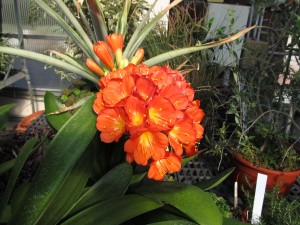If you’re suffering from the winter blahs, colorful orange clivia (Clivia miniata) flowers will brighten your home. This sub-tropical house plant is native to South Africa, a member of the lily family (Liliaceae), is easy to grow and re-blooms every year as amaryllis or Christmas cactus do. Its wide, strap-like dark evergreen leaves remain blemish free and attractive when not in bloom. The older bottom leaves eventually age and should be removed over time.
Start by purchasing a plant already budded or in flower. Clivia lives a long time as a potted house plant. An older plant will grow 2 to 3 feet tall and wide, and can get large and heavy. Grow in a large, wide-based clay pot that won’t tip over.
Outdoors, clivia grows best in bright daylight, and not in direct sun. It thrives outdoors from late May thru mid-September under a shade tree (USDA zones 6 and 7). Bring tender clivia back indoors when nighttime temps dip below 40 °F. Once indoors, water the plant very little for the next 8-10 weeks. If the leaves start to wilt during “dry period”, supply just enough water to perk them up. If possible, keep in a cool 50 to 55 °F room.
Your good care will reward you with a bouquet of orange lily-like flowers borne in a tall sturdy stem. By early January a thick flower stalk will emerge near the plant base, through the thick foliage.
The orange colored flower variety is most common, but the rare yellow-flowering variety is becoming more available for purchase. Remove the old floral stalk at the base when the flowers fade and wilt.
During the winter months, clivia prefers direct light from a bright north or eastern exposure window. Inside a grow room or greenhouse, do not expose to long periods of direct sunlight. During the spring and summer, clivia needs regular watering, but allow partial dry down between waterings. Do not mist the foliage or keep the potting medium constantly wet, as this may cause rot and promote leaf diseases.
In the spring and summer, regular watering and feeding are the rules. Once clivia has bloomed, fertilize monthly with a water-soluble fertilizer (20-20-20 or equivalent) mixed at 1/2 the rate recommended on the package. Do not fertilize in the fall and winter.
Clivia seem to prefer a near potbound condition. Plant should be divided and repotted every 3-5 years. Repotting can be performed any time after flowering. Set each division in a new 10 inch or larger diameter pot. Use an organically-based potting medium that drains well.


 Posted in
Posted in 
